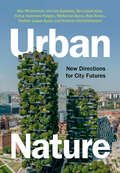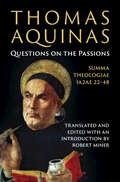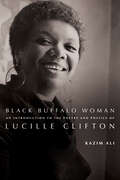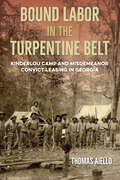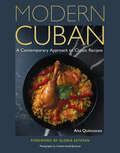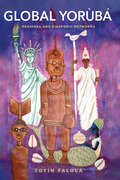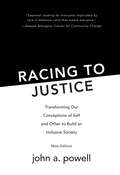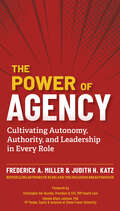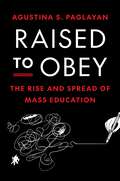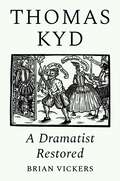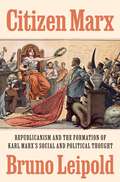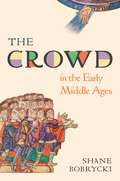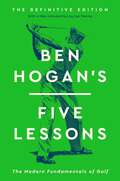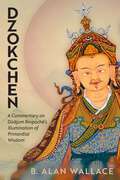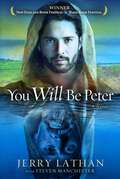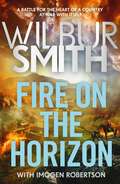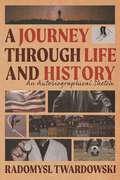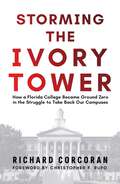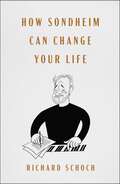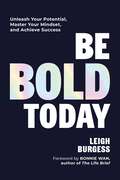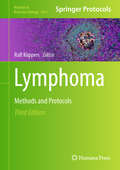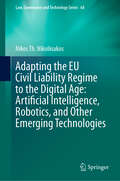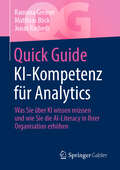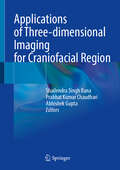- Table View
- List View
Urban Nature: New Directions for City Futures
by Kes McCormick Bernadett Kiss Yuliya Voytenko Palgan Harriet Bulkeley McKenna Davis Rob Raven Andrés Luque-Ayala Kathrin HörschelmannThis introductory textbook with a global scope aims to train students of geography, sustainability, and urban and environmental studies to re-imagine and transform cities to meet climate, biodiversity, and sustainability challenges. A dedicated team of authors critically examine the relationships between nature and urban areas, sharing an inspiring account of how nature helps us re-think our cities and their futures. Prior to this textbook, literature for courses covering urban nature was written by and for practitioners, whereas this textbook is written by experienced course instructors specifically to be accessible to diverse students. The textbook is illustrated with numerous photos and figures which bring key topics, challenges, and opportunities to life. It contains focus boxes and case studies from every continent, offering students an international scope and multiple entry points into the field. Chapters conclude with thought-provoking follow-up questions and recommended reading. The authors provide an array of supplementary online resources.
Thomas Aquinas: Summa Theologiae 1a2ae 22-48
by Robert MinerThomas Aquinas's Questions on the passions form part of the Summa Theologiae, Aquinas's best-known work. This first standalone edition shows, through a translation that is both rigorously accurate and mirrors the rapid tempo of Aquinas's Latin, what Aquinas says in his landmark treatment of the passions. Aquinas sets the parameters and terms of debate for numerous later theorists of the passions, including Descartes, Hobbes, Spinoza and Hume. Some have alleged that Paul and later Christians have (in Nietzsche's words) “an evil eye for the passions,” judging them as 'dirty, disfiguring and heartbreaking'. Yet readers of the present translation will perceive that Aquinas regards the passions as part of created nature, and thereby good in their essence. As they encounter Aquinas's treatment, they will also deepen their knowledge of particular passions-including love, hatred, desire, aversion, pleasure, sorrow, hope, despair, fear, and anger.
Black Buffalo Woman: An Introduction to the Poetry & Poetics of Lucille Clifton
by Kazim AliThis long-awaited and much-needed volume shines new light on one of America’s most beloved, and profound, poets—Lucille Clifton.Black Buffalo Woman is a deep, comprehensive dive into Clifton’s work through the eyes of celebrated poet and scholar, Kazim Ali. Collecting chapters of Clifton’s early manuscripts, late drafts, and integrating her books of children’s literature, Ali’s meticulously researched volume provides a brilliant and fresh perspective on Clifton’s life and work.Various chapters examine Clifton’s treatment of the body as a site of both joy and danger, spirituality, and interrogation of American history, politics, and popular culture. The result of Ali’s scholarship and care highlights a dazzling array of Clifton’s poetic techniques and forms that will continue to inspire poets for decades to come.
Udavikkaram May 2024: உதவிக்கரம் மே மாத இதழ் 2024
by T.A.P. Varadakuttiமாற்றுத்திறனாளிகளின் படைப்புகளை கட்டுரைகளாக தொகுத்தும், அவர்களுக்கு பல்வேறு இடங்களில் நடைபெற்ற கருத்தரங்குகள், பயிற்சி வகுப்புகள் பற்றிய தகவல்கள் மற்றும் உதவி உபகரணங்கள் வழங்கிய நிகழ்ச்சிகளை தொகுத்து மாதந்தோறும் இதழாக வெளியிடுகின்றனர்
Bound Labor in the Turpentine Belt: Kinderlou Camp and Misdemeanor Convict Leasing in Georgia
by Thomas AielloUncovering a little-known system of bound labor in the post-Reconstruction South After the constitutional end to slavery in the United States, southern white landowners replaced labor by enslaved people with systems of bound labor in which people worked to pay off debts or legal fines. Through the story of a labor camp in Georgia, Thomas Aiello takes a close look at the Deep South’s dependence on debt peonage and convict leasing systems during the post-Reconstruction era and draws attention to a form of bound labor that has not been discussed by scholars of racialized incarceration. At the center of this study is the Kinderlou labor camp, which was owned by the prominent white McRee family of Valdosta. In south Georgia and north Florida, debt peonage and felony convict leasing operated separately from an often overlooked third system: misdemeanor convict leasing. This system was largely unregulated by prison officials, leading to abuses of persons with convictions working in the turpentine industry and the kidnapping of many Black residents of the area who had never been charged with crimes. Unlike other work camps, Kinderlou deployed all three systems to bolster its workforce, making it a unique manifestation of the region’s exploitative labor operations. Through deep archival research, Aiello uncovers injustices that drove local individuals who were imprisoned to work with federal prosecutors to seek relief and publicize the abuses they saw and experienced. The nexus of racism, work, and incarceration seen at Kinderlou is shown here to have been a form of slavery a half century after slavery’s official “end.” It also casts a long shadow on today’s carceral system. Publication of this work made possible by a Sustaining the Humanities through the American Rescue Plan grant from the National Endowment for the Humanities.
Modern Cuban: A Contemporary Approach to Classic Recipes
by Ana QuincocesCooking delicious Cuban meals for people of all backgrounds Serving up a fresh take on Cuban food, Ana Quincoces reimagines traditional recipes for today’s home chefs in Modern Cuban. This cookbook unites generations by helping readers make timeless dishes that showcase the distinctive flavors of classic Cuban cuisine while crafting meals that are accessible to everyone. Modern Cuban shows how to welcome guests to an inclusive culinary celebration, demonstrating how many of these much-loved recipes can be tweaked or are already good fits for vegetarian, vegan, gluten-free, ketogenic, and other diets. With ingredients and alternatives that are easy to find or already in most home kitchens, learning Cuban cooking has never been so simple! Readers will find instructions for preparing essentials like fragrant sofrito and tangy mojo criollo along with irresistible croquetas, yuca frita (fried yuca), sopa de platano (plantain soup), picadillo (beef hash), buttery guava-filled pastelitos (pastries), flan de coco (coconut flan), and an abundance of other delectable sides, mains, and desserts. Accompanied by beautiful photos that present iconic dishes in a new, modern light, the recipes in this cookbook include Ana Quincoces’s personal memories of her family and the food culture they passed down to her. Modern Cuban is perfect for beginners and advanced cooks alike who want to celebrate Cuban favorites in ways that honor the past and present. Above all, this cookbook is for anyone who enjoys gathering good company for great food that feeds the soul. Buen provecho!
Global Yorùbá: Regional and Diasporic Networks
by Toyin FalolaIn Global Yorùbá, renowned scholar Toyin Falola covers the history, people, traditions, environment, religion, spirituality, cosmology, culture, and philosophy of one of Africa's largest cultural groups, the Yorùbá, all while considering the people's relationship with their immediate and distant neighbors. Falola examines how the Yorùbán people have adapted to their environment and tapped it to (re)invent their civilization, shape their culture and traditions, and inform their socioeconomic relations with their neighbors. These interactions have guided the Yorùbá philosophy that developed over time, expressing their conviction regarding society's evolution and the place that humans occupy within it. This web of knowledge can present a more coherent account than any other text yet produced regarding Yorùbá civilization. This volume demonstrates how global dynamics have been adopted in the creation of a Yorùbá community across different times and spaces.
Racing to Justice: Transforming Our Conceptions of Self and Other to Build an Inclusive Society
by john a powellIn Racing to Justice, renowned social justice advocate john a. powell persuasively argues that we have yet to achieve a truly post-racial society and that there is much work to be done to redeem the American promise of inclusive democracy.Gathered from a decade of writing about social justice and spirituality, these meditations on race, identity, and social policy provide an outline for laying claim to our shared humanity and a way toward healing ourselves and securing our future. With an updated foreword and a new chapter on polarization, this new edition continues to challenge us to replace the attitudes and institutions that promote and perpetuate social suffering with those that foster relationships and a way of being that transcends disconnection and separation.Racing to Justice is a thought-provoking book that offers readers a look into the issues that continue to plague our society. It is reminder that we have yet to address and reckon with the challenges we face in providing equal opportunities for all people in this country and the world.
The Power of Agency: Cultivating Autonomy, Authority, and Leadership in Every Role
by Frederick A. Miller Judith H. KatzTake ownership of your work and unleash the power of agency in your organization!To help give employees the power, influence, and voice necessary to truly excel in their workplace, organizational development experts Miller and Katz reveal the importance of agency and offer practical advice on how to achieve it.With more knowledge workers entering the workplace, many are being stifled by traditional employee-manager relationships that hamper their ability to fully contribute and feel engaged at work. And in a constantly changing and competitive world of work, organizations must evolve to keep up with worker satisfaction or else face a decrease in performance and loss in talent.The solution? Enabling your employees to exercise their individual agency in the workplace. Through an actionable roadmap that highlights common pitfalls and practical steps necessary for establishing a culture of greater agency, this book will provide individuals, teams, managers, and leaders with concrete ways to clarify their current level of agency and identifies specific actions they can take to exercise greater agency.
Raised to Obey: The Rise and Spread of Mass Education (The Princeton Economic History of the Western World)
by Agustina PaglayanHow the expansion of primary education in the West emerged not from democratic ideals but from the state&’s desire to control its citizensNearly every country today has universal primary education. But why did governments in the West decide to provide education to all children in the first place? In Raised to Obey, Agustina Paglayan offers an unsettling answer. The introduction of broadly accessible primary education was not mainly a response to industrialization, or fueled by democratic ideals, or even aimed at eradicating illiteracy or improving skills. It was motivated instead by elites&’ fear of the masses—and the desire to turn the &“savage,&” &“unruly,&” and &“morally flawed&” children of the lower classes into well-behaved future citizens who would obey the state and its laws.Drawing on unparalleled evidence from two centuries of education provision in Europe and the Americas, and deploying rich data that capture the expansion of primary education and its characteristics, this sweeping book offers a political history of primary schools that is both broad and deep. Paglayan shows that governments invested in primary schools when internal threats heightened political elites&’ anxiety around mass violence and the breakdown of social order.Two hundred years later, the original objective of disciplining children remains at the core of how most public schools around the world operate. The future of education systems—and their ability to reduce poverty and inequality—hinges on our ability to understand and come to terms with this troubling history.
Thomas Kyd: A Dramatist Restored
by Brian VickersA groundbreaking new account of the author of The Spanish Tragedy that establishes him as a major Elizabethan dramatistThomas Kyd (1558–1594) was a highly regarded dramatist and the author of The Spanish Tragedy, the first revenge tragedy and the most influential Elizabethan play. In this first full study of his life and works, Brian Vickers discusses Kyd&’s accepted canon as well as three additional plays Vickers has newly identified as having been written by Kyd—exciting discoveries that establish him as a major dramatist.Thomas Dekker, a fellow Elizabethan dramatist, referred to &“industrious Kyd,&” which suggests a greater output than the three plays traditionally attributed to him—The Spanish Tragedy, Soliman and Perseda, and Cornelia. Kyd worked between 1585 and 1594, when the plague led to the anonymous publication of many plays because of the breakup of several London theatre companies. Researching this corpus, Vickers has identified Kyd&’s authorship of three more plays: Arden of Faversham, the first domestic tragedy, King Leir and his three daughters, a tragicomedy that provided Shakespeare with his main source, and Fair Em, a love comedy. These attributions are based on two forms of evidence: unique similarities of plot between Kyd&’s acknowledged and newly attributed plays and many unique phrases shared by all six plays as identified by modern software.Discussing all the plays in detail and placing them in biographical and historical context, Thomas Kyd offers a major reassessment of an underappreciated Elizabethan playwright.
Citizen Marx: Republicanism and the Formation of Karl Marx’s Social and Political Thought
by Bruno LeipoldThe first book to offer a comprehensive exploration of Marx&’s relationship to republicanism, arguing that it is essential to understanding his thoughtIn Citizen Marx, Bruno Leipold argues that, contrary to certain interpretive commonplaces, Karl Marx&’s thinking was deeply informed by republicanism. Marx&’s relation to republicanism changed over the course of his life, but its complex influence on his thought cannot be reduced to wholesale adoption or rejection. Challenging common depictions of Marx that downplay or ignore his commitment to politics, democracy, and freedom, Leipold shows that Marx viewed democratic political institutions as crucial to overcoming the social unfreedom and domination of capitalism. One of Marx&’s principal political values, Leipold contends, was a republican conception of freedom, according to which one is unfree when subjected to arbitrary power.Placing Marx&’s republican communism in its historical context—but not consigning him to that context—Leipold traces Marx&’s shifting relationship to republicanism across three broad periods. First, Marx began his political life as a republican committed to a democratic republic in which citizens held active popular sovereignty. Second, he transitioned to communism, criticizing republicanism but incorporating the republican opposition to arbitrary power into his social critiques. He argued that although a democratic republic was not sufficient for emancipation, it was necessary for it. Third, spurred by the events of the Paris Commune of 1871, he came to view popular control in representation and public administration as essential to the realization of communism. Leipold shows how Marx positioned his republican communism to displace both antipolitical socialism and anticommunist republicanism. One of Marx&’s great contributions, Leipold suggests, was to place politics (and especially democratic politics) at the heart of socialism.
The Crowd in the Early Middle Ages (Histories of Economic Life)
by Dr. Shane BobryckiThe importance of collective behavior in early medieval EuropeBy the fifth and sixth centuries, the bread and circuses and triumphal processions of the Roman Empire had given way to a quieter world. And yet, as Shane Bobrycki argues, the influence and importance of the crowd did not disappear in early medieval Europe. In The Crowd in the Early Middle Ages, Bobrycki shows that although demographic change may have dispersed the urban multitudes of Greco-Roman civilization, collective behavior retained its social importance even when crowds were scarce.Most historians have seen early medieval Europe as a world without crowds. In fact, Bobrycki argues, early medieval European sources are full of crowds—although perhaps not the sort historians have trained themselves to look for. Harvests, markets, festivals, religious rites, and political assemblies were among the gatherings used to regulate resources and demonstrate legitimacy. Indeed, the refusal to assemble and other forms of &“slantwise&” assembly became a weapon of the powerless. Bobrycki investigates what happened when demographic realities shifted, but culture, religion, and politics remained bound by the past. The history of crowds during the five hundred years between the age of circuses and the age of crusades, Bobrycki shows, tells an important story—one of systemic and scalar change in economic and social life and of reorganization in the world of ideas and norms.
Ben Hogan's Five Lessons: The Modern Fundamentals of Golf
by Ben HoganWith a new introduction by Lee Trevino, this is the first definitive edition of the timeless golf classic that has sold over a million copies—now with never-before-seen photos and memorabilia, hand-selected from the Hogan estate archive, as well as nearly 100 pages of new writings that expand on Hogan&’s unbelievable life story and extraordinary career.Over the past sixty-five years, millions of golfers have studied Ben Hogan&’s Five Lessons, making it the bestselling golf book of all time. Now, Hogan&’s masterpiece has received the definitive edition it deserves. Widely regarded as one of the greatest golfers in the history of the sport, Hogan is especially known for his mastery of the golf swing. At the start of his career, he played with a hook that threatened to ruin his game, until he dedicated himself to correcting it—and in doing so, he gained a rare and hard-fought understanding of the fundamentals. Curious fans itched for clues about his legendary technique, dubbed &“the secret,&” that allowed him to persevere and even return to the height of his powers after a car crash that shattered his body and almost took his life in 1949. His terse answer, &“I dug it out of the dirt&”—the dirt of the driving range—fueled the Hogan mystique. He went on to become one of only five players to win all four professional championships, claiming nine major championships in total. In 1957, Hogan partnered with Herbert Warren Wind, &“the dean of American golf writers&” (The New York Times), and illustrator Anthony Ravielli to capture his expertise from the peak of his career in a series of lessons. Hogan believed that any golfer with average coordination can learn to break eighty. In each chapter, a different tested fundamental is explained and demonstrated with clear illustrations, as though Hogan were giving you a personal lesson with the same skill and precision that made him a legend. Now expanded with a new introduction by Lee Trevino, essays about Hogan and the book&’s legacy, unpublished photos of the publicity-shy Hogan, and more, this definitive edition offers greater context and fresh insight into an icon of the game.
Dzokchen: A Commentary on Dudjom Rinpoché's "Illumination of Primordial Wisdom"
by B. Alan WallacePith Instructions for Realizing the Great Perfection, from One of the Greatest Tibetan Yogis of the Twentieth Century.In the concise yet comprehensive practice manual entitled The Illumination of Primordial Consciousness, the great twentieth-century Tibetan Nyingma master Dudjom Rinpoche lays out a sequential path to spiritual freedom according to the teachings of the Great Perfection (Dzokchen): First, we refine our awareness by training in meditative quiescence (shamatha) and then proceed to the cultivation of contemplative insight (vipashyana), by which our mind&’s basic nature of luminosity and emptiness is revealed. Then, having recognized that the ordinary, deluded mind is actually without any intrinsic essence, we are primed to cut through this conditioned mind into unborn, timeless pristine awareness, which has never been contaminated by mental afflictions or other obscurations. Finally, we realize that our own awareness has never been other than the dharmakaya, the mind of a buddha, and perfect enlightenment is realized spontaneously and effortlessly. In this book, beloved teacher and renowned scholar Lama B. Alan Wallace shares insights gained over years of study, providing a line-by-line explanation interspersed with background teachings from revered Dzokchen scriptures written by Padmasambhava, Dudjom Lingpa, and others. Also included are a set of fifteen guided meditations given by Lama Alan, along with links to audio tracks of Lama Alan giving the instructions himself. Through the practices he describes, the mystery of the mind—its origin and what happens to it at death–is thus illuminated through one&’s own meditative experience.
You Will Be Peter
by Jerry LathanThe extraordinary story of a young fisherman who became the Founding Father of Christianity, the most influential and enduring institution in history.2023 Paris Book Festival Winner · 2023 New England Book Festival Winner He&’s one of the most well-known figures in cultures around the world, etched into stained glass, painted in frescoes, even caricatured as standing at the gates of heaven with a long white beard and keys in hand. But long before he was portrayed as a venerated and untouchable figure, Peter was simply known as Simon, a twenty-something fisherman in a far-flung Jewish province controlled by the Roman Empire. Loyal and faithful, impetuous and passionate, Simon&’s quiet life is upended by the arrival of a man called Jesus of Nazareth, rumored to be the long-awaited Messiah who would rescue the Jewish people from oppression. When Simon meets Jesus, the mysterious man tells him, &“You will be Peter,&” a prophetic statement that would slowly transform Simon&’s life. Eager to be free of the Romans, Simon joins Jesus in hopes that he can guard this leader who will, undoubtedly, build an army to challenge Rome. But as Simon waits for the army to form, he watches Jesus show a compassion for others Simon has never seen before. The miracles Jesus performs—healing the sick, feeding crowds of thousands—show not a display of military might, but of service and love. Real, relatable and impeccably researched, You Will Be Peter draws on the four Gospel accounts to weave Simon Peter&’s story into one seamless tapestry. Readers get a front-row seat to Simon&’s three-year walk with Jesus, as Simon watches the Son of Man feed the hungry, raise the dead, upend the status quo and challenge the elite during one of world history&’s most pivotal seasons. In perhaps one of the greatest miracles, we can see ourselves in Simon, this ordinary man Jesus chose to accompany Him. Simon wasn&’t well-educated, but he was faithful and headstrong. Though he could rush to judgment and use a foul word from time to time, he was the kind of friend who loved fiercely and was doggedly loyal—until he wasn&’t. Although he failed, Simon wasn&’t cast away from Jesus&’ mission. In fact, his failures and subsequent redemption made him a more empathetic and capable rock upon whom the Church was built. With storytelling artistry that transports readers to the first-century world, with the sights, sounds, and smells of that time, You Will Be Peter shares an age-old story told from a new set of eyes: it&’s possible for one ordinary person, however unlikely, to change the world forever.
Fire on the Horizon (The Ballantyne Series)
by Wilbur SmithThe sequel to worldwide bestsellers The Triumph of the Sun and King of Kings.A FAMILIAR FOE. A BATTLE FOR THE HEART OF A COUNTRY AT WAR WITH ITSELF. South Africa, 1899 - the smouldering hostility between the Boers of the Transvaal and Orange Free State and the British colonies of the Cape and Natal is about to burst into flame. War is coming and no one can prevent it. Colonel Penrod Ballantyne, hero of Abu Klea and Omdurman, is sent to Mafeking, 'the place of stones', to recruit and train men for the fighting ahead. Amber, his wife, the successful novelist, accompanies him - eager to see more of the country her husband is about to risk his life for. But when war is declared, Amber must flee with their baby son and pray for her husband's survival against impossible odds. Eight hundred miles to the south, in Cape Town, Ryder Courtney - adventurer, maverick, industrialist - is using his wealth and connections to bankroll the British war effort. His artist wife Saffron, frustrated by stuffy Cairo society, has joined him with their three children. There is peace in the Courtney household, or so Saffron believes, until their eldest son, Leon, stows away on a train to the front line, determined to join his distinguished uncle, Penrod Ballantyne, in changing the course of history. Saffron and Ryder have no choice but to leave the safety of the Cape Colony and follow. Leon is convinced that his parents are without honour and courage. Little does he realise that he has no chance of escaping the people they used to be. Two families torn apart, caught up in a battle for the heart of a country at war with itself. The Courtneys and the Ballantynes come together once again in the sequel to the worldwide bestsellers The Triumph of the Sun and King of Kings.
A Journey Through Life and History: An Autobiographical Sketch
by Radomysl Twardowski&“...an evocative autobiographical exploration of personal growth, resilience, and cultural identity…a compelling read for those interested in autobiographical tales that blend historical context with personal reflection.&” – Readers FavoriteRadomysl Twardowski's moving story of growing up in post-war Poland begins with early memories of walks around Krakow with his beloved Grandfather Karol. As it becomes clear to the young Rado that Poland's history is rooted in Christianity, the solemn grandeur and religious atmosphere of places like Wawel Cathedral and other churches begin to have a profound impact on him. He would later be drawn to SSPX and Latin Mass, a subject of debate in the Catholic Church after the Second Vatican Council. After the rise of Solidarity in 1980 and the declaration of martial law in 1981, Rado leaves Poland for the US, where he graduates from medical school and practices cardiology for several years, eventually becoming a proponent for fitness and wellness. Woven throughout this gripping memoir set against the backdrop of dramatic political, religious, and newsworthy developments are the author's stories of hardship and triumph over adversity-from a skiing injury at age twelve that left him with physical limitations to the dissolution of his marriage and a difficult separation from his children. Throughout this memorable journey through history, Twardowski offers us a deeply personal life story of exploration, loss, redemption, and survival.
Storming the Ivory Tower: How a Florida College Became Ground Zero in the Struggle to Take Back Our Campuses
by Richard CorcoranA firsthand account of how Richard Corcoran, former education commissioner of Florida, successfully took on powerful progressive interest groups, broke their monopoly, and paved the way for higher education reform across America.Covid alerted the nation to the reality that K-12 schools—private and public alike—were infested with ideologues bent on indoctrinating children. Then, three years after the beginning of the pandemic, the shocking response to Hamas&’s genocidal assault on Israel made Americans aware that the same tumor had wholly sickened our country&’s colleges and universities. Now, conservatives—and increasingly, moderates and old-school liberals—want to know exactly how the radical left captured higher education. Florida has been the vanguard in the war to restore sanity to higher education. And Richard Corcoran has been one of its commanding generals—and racking up wins. When Corcoran was Florida&’s education commissioner, he was the point person for reopening schools and banning mask mandates. He triumphed. Then, he was given a herculean task: remaking a college overrun by radicalism and cancel culture. In 2023, he moved into the president&’s office in Sarasota, took on a campus mob, and challenged a media firestorm. Just a year later, Corcoran achieved the seemingly impossible. He turned around New College of Florida. Now, free speech is protected. Violence and anti-Semitism are abolished. DEI bureaucracy is eliminated. And, already, enrollment records are being broken. Storming the Ivory Tower is the story of how Corcoran is winning the fight for freedom in hostile territory, and how others can join the battle.
How Sondheim Can Change Your Life
by Richard SchochDiscover the powerful and universal lessons from the music and lyrics of Stephen Sondheim, the genius behind such musical theater masterworks as Company, West Side Story, and Into the Woods.Stephen Sondheim died on November 26, 2021, but for countless fans around the world, he is &“still here,&” to quote one of his lyrics. With acclaimed revivals of his landmark shows occurring around the world and introducing new generations to the man who transformed American musical theater, Sondheim&’s legacy has only grown. What is it about such classic songs as &“Rose&’s Turn&” from Gypsy, &“Send in the Clowns&” from A Little Night Music, and &“Children Will Listen&” from Into the Woods that speaks to us so intimately and profoundly? How Sondheim Can Change Your Life makes the case that Sondheim&’s greatness—beyond the clever lyrics and adventurous music—rests in his ability to tell stories that relate to us all. From Louise&’s desire for freedom as Gypsy Rose Lee to Sweeney Todd&’s thirst for revenge, we as an audience relate easily to Sondheim&’s characters. His works understand us as much as we understand them. Following the arc of Sondheim&’s career, How Sondheim Can Change Your Life is rich with stories about productions and iconic performers, deep readings of his music and lyrics, and insights into his creative process. But more than that, it reveals how Sondheim&’s works can enrich our own lives.
Be BOLD Today: Unleash Your Potential, Master Your Mindset, and Achieve Success
by Leigh BurgessReady to make a change? Thousands of leaders have reached their goals using The BOLD Framework. With this roadmap for success, you will believe in yourself without question, own your destiny, learn from setbacks and success, and design a life you love."Be BOLD Today is an eye-opening self-help guide that celebrates innumerable possibilities, encouraging people to work toward bigger, brighter futures." —Foreword Reviews &“Compassionate and practical, Be BOLD Today offers a collection of actionable practices to help you expand your vision and potential. . . . This is not a book just to be read; it is designed to spur life-enhancing action.&” —Amy C. Edmondson, Novartis Professor of Leadership and Management, Harvard Business School; and author of Right Kind of Wrong: The Science of Failing Well Do you have a voice inside you that&’s nudging you to make a change? Maybe you feel stuck and want to try something completely new or you want to elevate what you are already doing to the next level. Using The BOLD Framework, created by visionary leader Leigh Burgess, Be BOLD Today serves as your personal guide for executing the necessary steps to taking charge of your life. Leigh inspires you to identify and achieve your personal and professional goals, large and small. Through this book, you will convert your dreams, aspirations, and goals into realities by following the four steps of The BOLD Framework: • Believe: Reframe limiting beliefs that hold you back and strengthen empowering beliefs that move you forward. • Own: You are the author of your story, and you have the power to shape its narrative, but first you need to own your choices. • Learn: Embrace continuous learning by using a growth mindset, being adaptable and resilient, and turning setbacks into setups for success. • Design: Design a life path to the destiny you desire—and deserve. Be BOLD Today gives you the tools to effect whatever transformative change you desire, so you too can live your own best life. MORE PRAISE FOR BE BOLD TODAY: &“Leigh has built her impressive career around helping women make bold moves in their careers and in their lives. Be BOLD Today is a definitive road map for every leader and aspiring leader to reach success using The BOLD Framework.&” —Jessica Sibley, CEO of TIME &“Leigh is on a mission to redefine bold. She reminds us that sometimes the most profound acts of boldness are the ones that do not make a sound. They are the quiet choices we make every single day that can shift the landscape of our lives.&” —Mita Mallick, Wall Street Journal & USA Today bestselling author of Reimagine Inclusion &“Be BOLD Today is a must-read for everyone who truly desires to thrive and live the life they want. Leigh reminds us that throughout life, you have to be bold and brave and willing to take risks—and potentially fail before you succeed. It&’s time to get comfortable being uncomfortable!&” —Shelley Zalis, CEO of The Female Quotient &“Through Be BOLD Today, you'll discover the power of The BOLD Framework to ignite meaningful change in your life. This is not just a book; it&’s a road map to wholehearted living and the courage to show up as your truest self.&” —Claude Silver, chief heart officer of VaynerMedia and author of the upcoming book Showing Up
Lymphoma: Methods and Protocols (Methods in Molecular Biology #2865)
by Ralf KüppersThis detailed volume expands upon the previous edition with key methods currently used in lymphoma research, partly specific for lymphoma research but often adaptable to the study of other cancers. New chapters explore the latest approaches for single cell B cell and T cell receptor sequencing, multiplexed immunophenotyping of lymphoma tissue samples, genetic manipulation and extended culture of human germinal center B cells, genetic mouse models of lymphomas, establishment of patient-derived xenograft models of lymphomas, and more. Written in the highly successful Methods in Molecular Biology series format, chapters include introductions to their respective topics, lists of the necessary materials and reagents, step-by-step and readily reproducible laboratory protocols, and tips on troubleshooting and avoiding known pitfalls. Authoritative and up-to-day, Lymphoma: Methods and Protocols, Third Edition serves as a valuable resource for hematologists, hematopathologists, and scientists interested in a variety of topics in cancer research, human genetics, and immunology.
Adapting the EU Civil Liability Regime to the Digital Age: Artificial Intelligence, Robotics, and Other Emerging Technologies (Law, Governance and Technology Series #68)
by Nikos Th. NikolinakosThis book highlights the challenges that artificial intelligence (AI), robotics, the Internet of Things (IoT), and other emerging digital technologies pose to existing EU and national liability legislation, while also tracing the evolution of the relevant EU policy and legal framework. Recognising that Member States’ current national fault-based liability rules are ill-suited to handle compensation claims for AI-related harm, the book emphasises the difficulty victims face in proving fault and causation due to AI’s unique characteristics, such as autonomy and opacity (“black box” effect). Similarly, the current Product Liability Directive (PLD) has several shortcomings: certain products, economic actors, and types of damage in the digital and circular economy are not covered under strict liability; proving defectiveness and establishing a causal link with damage, especially for complex products, is often challenging; in addition, liability claims are subject to restrictive limits and thresholds. The book discusses in detail the European Commission’s proposal for a Directive on harmonising civil liability rules for damage caused by AI systems (the ‘proposed AI Liability Directive’). It also offers a thorough analysis of the European Commission’s proposal for a revised Product Liability Directive, compares it with the positions of the Council of the EU and the European Parliament, and discusses the final text approved by the Plenary of the European Parliament in March 2024. The book incorporates comments from various parties, offering insights into the approaches of EU institutions and the conflicting interests among stakeholders. Presenting carefully grounded arguments, this volume serves as a valuable resource for understanding the interplay between policy and law within the new EU liability framework for AI and other innovative products. This forthcoming EU regime represents a significant shift in the liability landscape, potentially heightening litigation risks. Its success will depend on achieving the EU’s overarching objective: ensuring fair compensation while fostering technological innovation.
Quick Guide KI-Kompetenz für Analytics: Was Sie über KI wissen müssen und wie Sie die AI-Literacy in Ihrer Organisation erhöhen (Quick Guide)
by Ramona Greiner Matthias Böck Jonas RashediDieses Buch bietet Ihnen einen praktischen Einstieg in die Welt der Künstlichen Intelligenz (KI) und Data Science. Es hinterfragt aktuelle Hypes und ist ein praxiserprobter Guide mit konkreten Schritten für den sinnvollen Einsatz von einfachen bis komplexeren KI-Anwendungen im Unternehmen – mit Schwerpunkt auf Data Analytics und Web-/App-Tracking.In welchen Einsatzbereichen steckt das meiste Potenzial? Wie bestimmen Sie den KI-Reifegrad Ihres Unternehmens und wie planen Sie Ihre KI-Weiterbildungsoffensive? Welche wirtschaftlichen, ethischen und ökologischen Risiken sollten Sie berücksichtigen? Antworten darauf erhalten Sie in diesem Quick Guide – mit zahlreichen Tipps, Methoden und Vorlagen für den Transfer in Ihr Unternehmen. Ein Buch für alle, die sich die Möglichkeiten von KI-Anwendungen jetzt erschließen und schon bald davon profitieren wollen. Der InhaltGrundlagen und historische EinordnungEinsatzbereiche von KIim Bereich AnalyticsRisiken und Chancen beim Einsatz von KI im UnternehmenKI-Governance in fünf konkreten SchrittenAI & Data Analytics trifft Recht: AI Act und DSGVOKI-Strategie aus Ihrer Geschäftsstrategie ableitenKI-Kompetenz im Unternehmen erhöhen – mit Self-Assessment, Gap-Analyse und KI-Kompetenz-CanvasVom Scheitern lernen: Der Friedhof der KI-ProjekteWas Sie aus diesem Buch mitnehmen werden:Warum wir im Zeitalter der allgegenwärtigen Künstlichen Intelligenz alle zumindest ein bisschen zu Data Scientists werden müssenWie sich die Teildisziplinen von Künstlicher Intelligenz und Data Science zueinander verhaltenWas Machine Learning und Deep Learning eigentlich sind und was das mit Neuronalen Netzen zu tun hatWie sich die genAI, also generative Künstliche Intelligenz, in verschiedenen Domänen (Sprache, Bild, Musik etc.) entwickelt Wo aktuelldas meiste Potenzial für den Einsatz von KI steckt und welche Bereiche Sie sich deshalb genauer ansehen solltenWo Sie KI in Ihrem Alltag direkt anwenden können, um Aufgaben schneller und einfacher zu erledigenWelche wirtschaftlichen, ethischen und ökologischen Risiken und Chancen Sie beim Einsatz von KI berücksichtigen solltenWieso eine Kosten-Nutzen-Abwägung erfolgen sollte, bevor ein KI-Projekt gestartet wirdWie Sie die Ziele Ihrer KI-Governance festlegenWorauf Sie bei der Umsetzung Ihrer GovernanceWelche rechtlichen Entwicklungen im Bereich von Data Procurement und Data Analytics zu erwarten sindGrundlegende Schritte zur Bewertung der Anwendbarkeit des Gesetzes auf spezifische Praktiken durch FallstudienanalysenWie sich Ihre KI-Strategie in der Praxis umsetzen lässt (am Beispiel von Conversion Rate Optimization)Warum sich KI-Kompetenz und KI-Strategie gegenseitig bedingen und wie Sie dieses Henne-AI-Problem lösen könnenWie Sie bestimmen, welchen KI-Reifegrad Ihr Unternehmen gerade hat und welchen es erreichen möchteWie Sie die vorhandene KI-Kompetenz in Ihrem Unternehmen erheben und anhand eines Zielbildes und einer Gap-Analyse herausfinden, auf welche Bereiche Sie sich bei Ihrer Weiterbildungsoffensive konzentrieren solltenWie Sie Ihre Weiterbildungsoffensive mit einem Canvas planen Wie wir mit den Hypes im Zeitalter der KI umgehen solltenWarum es KI-Kompetenz und kritisches Denken braucht, um herauszufinden, aus welchen Fehlern und Projekten man wirklich lernen kann - mit Self-Assessment und Gap-AnalyseWas Scheitern mit Ihrer Datenkultur zu tun hat und wie diese gefördert werden kann MitSelf-Assessment und Gap-Analyse für die KI-Kompetenz Ihres UnternehmensZahlreichen konkreten Tipps für den Transfer in Ihr Unternehmen
Applications of Three-dimensional Imaging for Craniofacial Region
by Shailendra Singh Rana Prabhat Kumar Chaudhari Abhishek GuptaThe book provides sound knowledge of 3D imaging of dentofacial craniofacial region. It guides the students and faculty for understanding the dentofacial craniofacial region in depth. It incorporates the latest techniques, frameworks and technologies in the imaging area of oral health. The book emphasizes on the dentofacial and craniofacial region and thus fills the gap in the medical imaging literature. The development in this book is not only on the imaging techniques but also emphasis will be on the three-dimensional (3D) frameworks to deal the patients for their diagnosis and treatment planning. The chapters of this book are designed in such a way that the readers may get the complete package of the exploration of the imaging clinical applications of craniofacial areas. This book will be helpful not only for the students and faculty but also for the researchers working in the relevant areas.This book will provide easy, simple way but the most authentic material to learn the craniofacial region imaging. In this manual we will incorporates authentic, internationally accepted terms and definition. To make it interesting and simple, our approach is to incorporate the material in systematic manner in a simple and easy way by incorporating maximum illustrations and flowcharts. This book provides sound knowledge of various advanced technologies for dentist imaging. This book will highlights the importance and explore the current research in the dentofacial and craniofacial areas.
